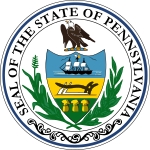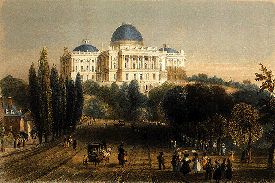On November 4, 1836, a special election was held in Pennsylvania's 13th congressional district to fill a vacancy left by the October 30th, 1836 resignation of Jesse Miller (J). [1]
| Elections in Pennsylvania |
|---|
 |
On November 4, 1836, a special election was held in Pennsylvania's 13th congressional district to fill a vacancy left by the October 30th, 1836 resignation of Jesse Miller (J). [1]
| Candidate | Party | Votes [2] | Percent |
|---|---|---|---|
| James Black | Jacksonian | 3,579 | 57.5% |
| Robert Elliott | Anti-Jacksonian | 2,742 | 42.5% |
Black took his seat December 5, 1836, at the start of the 2nd session of the 24th Congress. [3]

The 24th United States Congress was a meeting of the legislative branch of the United States federal government, consisting of the United States Senate and the United States House of Representatives. It met in Washington, D.C. from March 4, 1835, to March 4, 1837, during the seventh and eighth years of Andrew Jackson's presidency. The apportionment of seats in the House of Representatives was based on the 1830 United States census. Both chambers had a Jacksonian majority.

The 1838–39 United States House of Representatives elections were held on various dates in various states between July 2, 1838, and November 5, 1839. Each state set its own date for its elections to the House of Representatives before the first session of the 26th United States Congress convened on December 2, 1839. They occurred during President Martin Van Buren's term. Elections were held for all 242 seats, representing 26 states.
The 1836–37 United States House of Representatives elections were held on various dates in various states between July 4, 1836, and November 7, 1837. Each state set its own date for its elections to the House of Representatives, either before or after the first session of the 25th United States Congress convened on September 4, 1837. With Arkansas and Michigan officially achieving statehood in 1836 and 1837, respectively, the size of the House was set at 242 seats.

The 1834–35 United States House of Representatives elections were held on various dates in various states between July 7, 1834, and November 5, 1835. Each state set its own date for its elections to the House of Representatives before the first session of the 24th United States Congress convened on December 7, 1835. They were held during President Andrew Jackson's second term. Elections were held for 240 seats that represented 24 states, as well as the at-large-district seat for the pending new state of Michigan.

The 1836–37 United States Senate elections were held on various dates in various states. As these U.S. Senate elections were prior to the ratification of the Seventeenth Amendment in 1913, senators were chosen by state legislatures. Senators were elected over a wide range of time throughout 1836 and 1837, and a seat may have been filled months late or remained vacant due to legislative deadlock. In these elections, terms were up for the senators in Class 3.

In the 1816 elections in Pennsylvania, David Scott (DR) won one of the two seats in the 10th district, but resigned before the 15th Congress began, having been appointed judge of the court of common pleas. A special election was held on October 14, 1817, to fill the resulting vacancy.

In April, 1821, prior to the first meeting of the 17th Congress, Representative-elect James Duncan (DR) from Pennsylvania's 5th district resigned. A special election was held to fill the resulting vacancy on October 9, 1821.

On May 8, 1822, the last day of the First Session of the 17th Congress, William Milnor (F) of Pennsylvania's 1st district resigned. A special election was held to fill the resulting vacancy on October 1, 1822, a week before the general elections for the 18th Congress.

On May 8, 1822, the last day of the First Session of the 17th Congress, Henry Baldwin (DR) of Pennsylvania's 14th district resigned from Congress. A special election was held on October 1, 1822, to fill the resulting vacancy.

On January 12, 1826, Patrick Farrelly (J) of Pennsylvania's 18th district died in office. A special election was held to fill the resulting vacancy

On May 1, 1826, Alexander Thomson (J) of Pennsylvania's 13th district resigned. A special election was held to fill the resulting vacancy on October 10, 1826, the same day as the general elections to the 20th Congress.

On November 22, 1831, a special election was held in Pennsylvania's 11th congressional district to fill a vacancy caused by the death of William Ramsey (D) on September 29, 1831.

On October 11, 1836, a special election was held in Pennsylvania's 24th congressional district, to fill a vacancy left by the resignation of John Banks (AM) on April 2. This election was held at the same time as the general elections for the 25th Congress

On June 29, 1837, a special election was held in Pennsylvania's 3rd congressional district to fill a vacancy left by the death of Francis J. Harper (D) on March 18, 1837.

On March 8, 1838, a special election was held in Pennsylvania's 9th congressional district to fill a vacancy left by the resignation of Henry A. P. Muhlenberg (D) on February 9, 1838.

On November 20, 1839, a special election was held in Pennsylvania's 14th congressional district to fill a vacancy caused by the death of William W. Potter (D) on October 28 of that year, before the start of the first session of the 26th Congress.

On October 13, 1840, the same day as the general elections for the 27th Congress, a special election was held in Pennsylvania's 22nd congressional district to fill a vacancy caused by the resignation of Richard Biddle (AM).

On November 20, 1840, a special election was held in Pennsylvania's 13th congressional district to fill a vacancy caused by the death of William S. Ramsey on October 17 of the same year.
On May 4, 1841, a special election was held in Pennsylvania's 13th congressional district to fill a vacancy caused by the death of William S. Ramsey (D) on October 17, 1840, shortly after his re-election, and before the 26th Congress had ended.